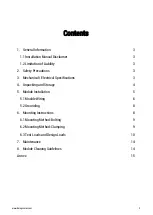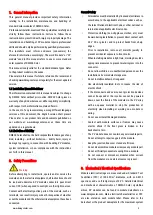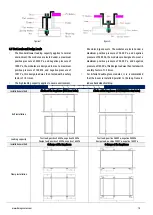
DMEGC Solar PV Modules Installation Manual
voltage.
Under certain conditions, a module may produce more current
or voltage than its Standard Test Conditions rated power. As a
result, the module short-circuit current under STC should be
multiplied by 1.25, and a correction factor should be applied to
the open-circuit voltage (
see Table 1 below
), when determining
component ratings and capacities. Depending on your local
regulations, an additional 1.25 multiplier for the short-circuit
current (giving a total multiplier of 1.56) may be applicable
when sizing conductors and fuses.
Table 1: Low temperature correction factors for open-circuit voltage
Lowest Expected Ambient
Temperature (
° C
/
°F
)
Correction Factor
24 to 20 / 76 to 68
1.02
19 to 15 / 67 to 59
1.04
14 to 10 / 58 to 50
1.06
9 to 5 / 49 to 41
1.08
4 to 0 / 40 to 32
1.10
-1 to -5 / 31 to 23
1.12
-6 to -10 / 22 to 14
1.14
-11 to -15 / 13 to 5
1.16
-16 to -20 / 4 to -4
1.18
-21 to -25 / -5 to -13
1.20
-26 to -30 / -14 to -22
1.21
-31 to -35 / -23 to -31
1.23
-36 to -40 / -32 to -40
1.25
Alternatively, a more accurate correction factor for the open-
circuit voltage can be calculated using the following formula:
C
Voc
= 1 −
α
Voc
× (25 – T)
T (°C)
is the lowest expected ambient temperature at the
system installation site.
α
Voc
(%/°C)
is the voltage temperature coefficient of the
selected module (refer to corresponding datasheet).
Electrical calculations and design must be performed by a
competent engineer or consultant.
Please contact DMEGC Solar’s technical support team for
additional information pertaining to engineering optimization
and approval of project specific module string lengths.
4.
Unpacking and Storage
Precautions
•
Modules should be stored in a dry and ventilated
environment to avoid direct sunlight and moisture. If
modules are stored in an uncontrolled environment, the
storage time should be less than 3 months and extra
precautions should be taken to prevent connectors from
being exposed to moisture or sunlight, like using
connector endcaps. In any circumstance, for pallets of
modules packaged in landscape orientation, stacking of
no more than two layers is allowed, for pallets of modules
packaged in portrait orientation, stacking is not allowed.
•
When unloading modules pallets from flat truck, please
use a crane or a forklift to remove the module pallets.
When unloading modules pallets from containers, please
use a fork lift to remove the module pallets, and the
forklift should be close to the ground in order to avoid the
top of module pallets touching the top of the cabinet door.
Consult your DMEGC Solar's representative for more
detailed unloading instructions.
•
Unpack module pallets carefully, following the steps
shown on the pallet. Unpack, transport and store the
modules with care.
•
Modules must always be unpacked and installed by two
or three people. Always use both hands when handling
modules.
•
Do not lift modules by their wires or junction box, lift them
by the frame.
•
Do not allow the panels to sag or bow under their own
weight when being carried.
•
Stacks of modules should contain no more than 12
modules, and the frames should be aligned.
•
Do not place excessive loads on the module or twist the
module frame.
•
Do not stand, step, walk and/or jump on modules under
any circumstances. Localized heavy loads may cause
severe micro-cracks at cell level, which in turn may
compromise module reliability and void DMEGC Solar’s
warranty.
•
Do not leave the module backsheet directly in contact
with the support structure underneath when handling or
installing the module.
•
Do not carry modules on your head.
•
Do not drop or place objects (such as tools) on the
modules.
•
Do not use sharp instruments on the modules. Particular
care should be taken to avoid module backsheets being
damaged by sharp objects, as scratches may directly
affect product safety.
•
Do not leave modules unsupported or unsecured.
•
Do not change the wiring of bypass diodes.


































